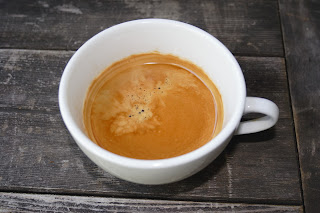What is a "Flat White"?
Flat White is an espresso-based drink that originated in Australia and was perfected in New Zealand, and is currently spreading around the world at the hands of ex-patriot Kiwis and Aussies.
There are several things about the "flat white" that would surprise an American used to Starbucks coffee.
First is the rich and velvety texture of the flat white, making for an exceptionally pleasing drink in the mouth.
The second surprise is the size of the drink, typically served in a 165 ml tulip-shaped cup, which is a mere 5 1/2 ounces! But quality matters over quantity, and this king of espresso-based drinks is not to be drowned in milk, but rather supported by the milk.
In helping you to understand what a flat white is, let's compare them to a couple of other espresso-based drinks that I'm sure you are aware of: the cappuccino and the caffe latte.
Let's say the cappuccino is the "Marge Simpson" of espresso-based drinks, with the milk whipped into a bubbly froth and placed on top of the espresso like a high Marge Simpson "bee-hive" do.
The latte, on the other hand, has had a hair cut, but nonetheless, has enough froth left in the milk to top the drink off with a slight bit of teasing on top.
The flat white, on the other hand, doesn't have any of that volume on top, but rather has all that tease distributed throughout the espresso, giving it a rich, velvety feel texture, where the coffee dominates.
How to make a flat white at home
Let's start out with the "ingredients" list. No substitutions allowed, otherwise it's not a flat white!
- fresh whole medium to light-roast coffee beans (throw away those beliefs that espresso is made with dark-roasted beans). If you are buying your beans from a West Coast U.S. roaster, they will often refer to light and medium roasts as "mid city" and "full city" roasts. Grind the beans to a fine espresso grind at the time of making your flat white.
- a heated 165 ml / 5.5 oz ceramic cup. "Tulip-shaped" is the standard, but if you haven't got any that shape, just make sure it's not a large cup, or restrict how much milk you add to the espresso if it is larger.
- a double shot of espresso with a good layer of crema floating on top (ristretto - i.e. a short extraction; because of the high ratio of coffee to milk, you need to avoid any of the bitterness that results from a longer extraction)
- whole milk that has been "stretched", not foamed (never use reduced fat milk for a flat white - forget those urges to diet; one flat white a day is not going to make you fat)
Let's take it for granted that you've read all I've written here about making your espresso pull, rich with crema on top. So on to the milk.
The milk for a flat white should not have any of the dry foam on top of it that is typical for making a caffe latte or cappuccino. The term used for what you do to the milk is "stretching". This is achieved by keeping the tip of the steaming wand slightly lower into the milk than usual so as not to break the surface of the milk at all. Your aim is not to introduce air into the milk. The heating of the milk and circulation of the milk in the pitcher will result in the milk becoming stretched. The volume should more than double in size and the milk should appear somewhat glassy and shiny when done. The milk should be heated to approximately 60° C / 140° F.
If you have a domestic machine that doesn't have a double-boiler, then an acceptable alternative is to use an
aerolatte whisk, once again taking care not to break the surface of the milk, and if necessary folding the milk at the end. You can read all about this technique here:
how to foam milk for your espresso-based drinks.
If you have succeeded in making good stretched milk, there will be no dry foam on top. Pull your espresso shot in the later stages of your milk preparation or immediately after. Just before pouring hte milk into the espresso, bang the bottom of the pitcher onto a cloth on your counter top to break any air bubbles in the milk, and swirl the pitcher a couple of times. Finally gently pour the milk into the espresso so that the crema from the espresso floats on top of the milk. Voila! All going well you have made your first delicious flat white.
Flat-White lends itself well to making what is referred to as Latte Art. I don't profess to be an expert at latte art, however, with a bit of practice you might be able to create patterns such as leaves and hearts as you will see on any flat white made in Australia or New Zealand, and in the better independent coffee shops in the U.S. But first of all just perfect making a great flat-white; it tastes just as good when well-made without any fancy art on top. Even without any latte art, the caramel-colored espresso crema floating on top of the drink is a work of art in itself!
Now that I've wetted your appetite for a flat white, why not try making one at home. To get going you will initially need to make an investment in some appliances, so here are my
recommendation for a home espresso maker and a
coffee grinder.











